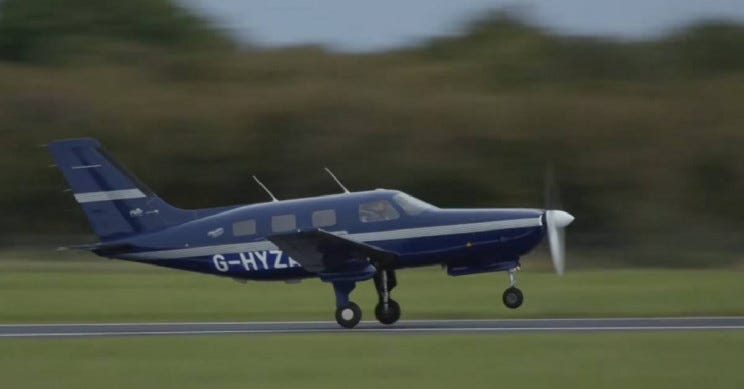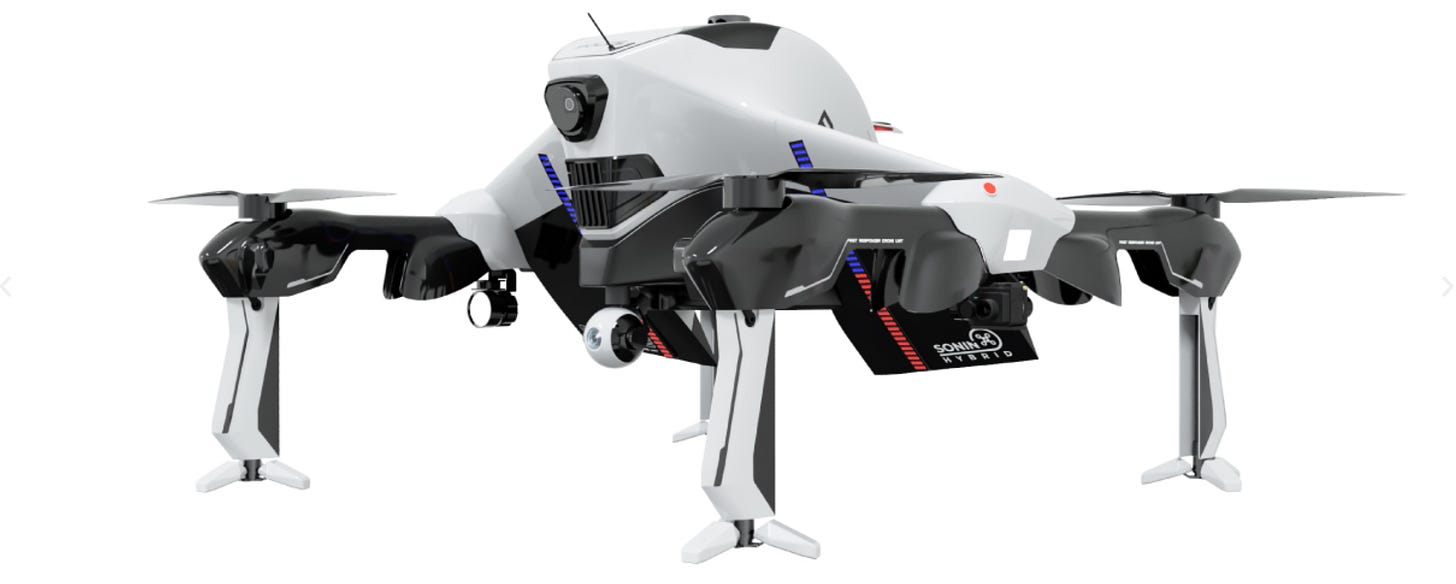This week we will look at a development in Carbon based computing which promises improvements in computational power and over a thousand fold improvement in power consumption. We also look at an artificial skin that feels pain, some more hydrogen powered planes and a drone specifically designed for first responders (Police, Ambulance, Fire etc.).
Finally I offer some bonus content to the truly dedicated readers (and you will need to be truly dedicated). It was tough to write and probably even tougher to read. If you want to discover a mathematical proof that paradox free time travel may be possible, scroll down to the bottom of the newsletter. I make an attempt at an explanation. If any reader wants to offer a simpler or more accurate explanation I would welcome it. Thanks to one of my readers on LinkedIn for bringing this advance to my attention.
Carbon Computing
Researchers at UC Berkley have created a metallic wire made entirely of carbon. This might pave the way for carbon based transistors and computers. Transistors based upon carbon rather than silicon could potentially boost performance and cut power consumption more than a thousandfold. A mobile phone could hold its’ charge for months.
The team used Graphene nano ribbons, which are narrow one dimensional strips, a single atom thick. Graphene is completely structured from carbon atoms arranged in an interconnected hexagonal pattern resembling chicken wire. The new carbon based metal is designed for conducting electrons between semi-conducting nano ribbons in all-carbon transistors.

We are currently reaching the speed limits for silicon based computing. It is also becoming more difficult to reduce power consumption. Carbon based computers could potentially calculate many times faster than silicon computers and only use a fraction of the power.
Graphene was discovered in 2004. This is yet another use of Graphene that is just now being developed (remember the curved graphene super capacitor from Estonian company, Skeleton, that we mentioned a few weeks ago). Many of the new technologies of the coming years will be due to the advances in material science over the past 20 or so years.
Artificial Skin that can feel pain
Royal Melbourne Institute of Technology researchers have developed an artificial skin that can feel pain just like human skin. This will open the way to better prosthetics, smarter robots and other non invasive alternatives to skin grafts.

The device electronically replicates the way that human skin feels pain. The device mimics the body’s near instant feedback response and reacts to painful sensations with the same lightning speed that nerve signals travel to the brain.
The team has also developed skins using stretchable electronics that can sense and respond to changes in temperature and pressure. The artificial skin can tell the difference between lightly touching the skin with a pin and jabbing yourself with a pin. This is the first time that this has been achieved electronically.
Another Hydrogen Powered Plane
Last week we spoke about the Airbus goal of launching Hydrogen Powered Planes by 2035. This requires a full design and build of new aircraft. Startup Universal Hydrogen has now kicked off its’ project to develop a hydrogen powertrain that can be retrofitted into existing aircraft.
The LA based company is set to test its’ technology on a 56 seater Dash-8 aircraft. Airbus is planning to burn hydrogen as a fuel where as Universal will use hydrogen to generate electricity for a fully electric powertrain. They use Magnix electric motors specifically built for the Dash-8’s turboprops. Earlier this year Magnix powered a 9 seater Cessna, the largest battery powered electric aircraft to date.

The plane will have a reduced capacity (40 v 56 seats) due to the need to store the hydrogen and a range of 750 kilometers. The issue for hydrogen powered planes is proving the safety of the product (some of my readers might old enough to remember the Hindenburg). The company hopes to have commercial versions of the powertrain retrofitted into aircraft by 2024.
Meanwhile ZeroAvia from Cranfield, England has already launched their first hydrogen fuel cell powered test flight. They used a Piper M 6 seat plane and performed a taxi, takeoff, full pattern circuit and landing.

Their goal is to develop smaller clean aircraft to enable point to point transportation. In California only 10 of the states 250 airports provide scheduled services. By using smaller airports they can take advantage of existing infrastructure to provide a cheaper cleaner service.
First Responder Drone that Recharges in Flight
Sonin Hybrid from Atlanta have released a 225kph drone built for first responders. The drone can fly for over 3 hours and recharge itself in flight by using a combination petrol and battery powered system. Equipped with a 30 times optical/12 times digital zoom 4k video camera with fixed and mobile target tracking, a Forward looking Infrared camera with night vision, PA speakers and a spotlight.

The drone is targeted at search and rescue, police operations and fire fighting reconnaissance. Drones arriving first on scene can give responders vital information and allow preparation time for the task ahead.
Paying it Forward
If you have a start-up or know of a start-up that has a product ready for market please let me know. I would be happy to have a look and feature the startup in this newsletter. Also if any startups need introductions please get in touch and I will help where I can.
If you have any questions or comments please email me via my website craigcarlyon.com or comment below.
I would also appreciate it if you could forward this newsletter to anyone that you think might be interested.
Till next week.
Bonus Content
Paradox Free Time Travel
A while ago we examined a simulation of the butterfly effect. We asked the question “do insignificant events have profound and divergent effects on larger systems”? If we went back in time and made a small change would the future look different? The simulation found that in a highly correlated system information is essentially restored by the end of the simulation. Meaning that there was no butterfly effect. This however was just a simulation. What if we travelled back in time in real life? Could we change our own futures?
University of Queensland student Germain Tobar claims to have worked out the math that shows that paradox free time travel might be theoretically possible in our Universe. The full paper is here. I will attempt to explain it as simply as possible (most of the paper is beyond my comprehension but here goes).
Classical Physics relies on the idea that systems evolve through time according to a set of dynamic laws. The current status of the system at any time reflects the entire history of the system (i.e. today we are the sum of all of the things that have happened to us).
General Relativity challenges this view. Einstein described the relationship between spacetime geometry and mass energy through counterintuitive solutions containing closed time-like curves (CTC). An event on a curve would be both in the future and in the past of itself (we are going to have to suspend disbelief for a little while and just go with the flow, this stuff is quite unusual). This prevents an ordinary formation of a system.
A brief aside. We are not sure that CTCs are possible in our universe. One theory combines quantum physics with general relativity, where spacetime loses its classical properties thus leading to indefinite causal structures (i.e. the current state of a system does not reflect its’ history). The problem with abandoning the causal theory is the ‘grandfather paradox’. If a time time traveller travelled back in time and killed their own grandfather they would never be born and thus cease to exist. If I killed my grandfather and I still existed we have encountered a logical inconsistency. Thus it is difficult to abandon causal theory and stay logically consistent.
Tobar takes a different approach. The ‘process matrix formalism’ approach assumes the local validity of the ordinary laws of physics and asks what type of global processes are consistent with this assumption. In this he considers regions that do not contain CTCs however might be traversed by CTCs (i.e. a closed time curve entering from another region and exiting to a third). The CTC enters the region from the past boundary, an arbitrary deterministic operation is performed and the CTC exits via the future boundary. For all three regions, all non causally ordered processes are essentially equivalent.
Tobar then extends the characterization to an arbitrary number of regions. He finds that when fixing the state of the future of all but 2 regions, those 2 regions must be causally ordered with only one direction signaling possible. This shows that for an arbitrary number of localized regions, non-trivial time travel between multiple regions is consistent with the absence of a logical paradox as long as, once the outputs of all but two regions are fixed, at most one-way signaling is possible. In other words you can’t go back in time and kill your grandfather.
Hmmmm. Clear as mud? As Arthur Dent said “it is time for a cup of tea and a good lie down” but first, where did I leave my towel (some will get the reference).
Now that I can rest easy in the knowledge that this week is immutable, I look forward to next week, which is very much still up for creation.


